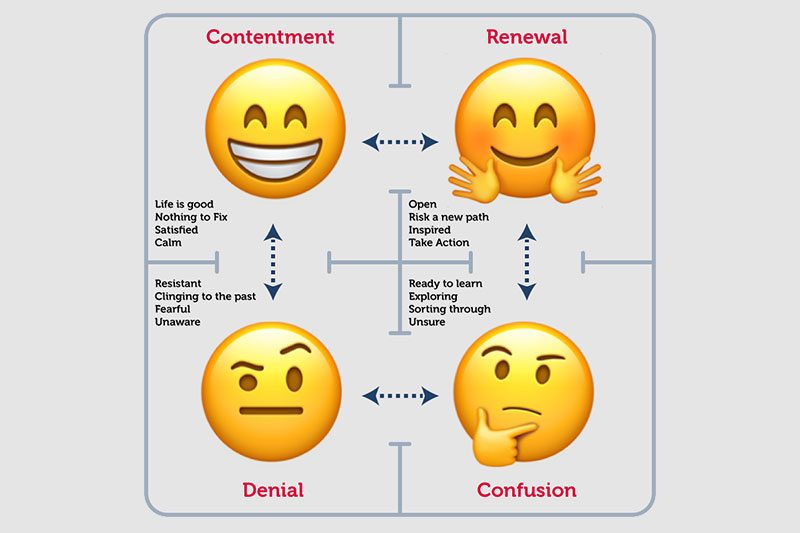Last month (April 2019) we introduced you to Claes Janssen’s ‘Four Rooms of Change’ as a way of viewing change as a perpetual activity which requires us to be continually aware and responsive to it. The four rooms – Contentment, Denial, Confusion and Renewal represent states a person or team may find themselves in physically and mentally, which impact on our ability to manage and progress through change.
Now we will explore HOW we can recognise and move people through the rooms. Change by its name and nature is not static, neither should we be. The starting point for any leader is to analyse – what are they seeing and experiencing in their people and organisation? It’s the same with the Four Rooms, we need to understand what is happening in order to adopt the right strategy and tactics.

Recognising and moving out of Contentment
In contentment we will hear people talking about being market leaders, being in a stable market, having a good performance and track record, we will hear about making decisions later and the classic ‘if it isn’t broken, don’t fix it’. We may see a lack of awareness about competitors; leaders may not listen to staff or lack any sense of urgency. Focus will be more on day to day transactional activities than forward thinking and planning. People feel happy where they are.
We want people to become more aware and start thinking about change in the team or organisation and the need for it at this time, though we may not be getting people to accept yet that things need to change. This is about:
- Challenging individual and organisational thinking and assumptions
- Identifying external best practice, trends and shifts in customer expectations
- Providing challenging feedback around performance
- Getting employees to visit customers and other organisations
- Identifying and using thought leaders in the industry
A coaching leader will use powerful and challenging questions to create awareness and stimulation. This will challenge employee apathy and challenge ‘groupthink’ by waking them up to the situation around them.

Challenging and Reducing Denial
Once we have developed an awareness of the situation, we will begin to experience elements of denial – “It’s happening across the industry. It’s not just us. We have always done it this way. Our business is different to our competitors. It’s a short-term issue. It’s adjusted for.” Resistors will blame other people, comment that we are wrong in our observations, or worse still look to ‘shoot down’ those who dare to try to be progressive; they will be protective of the present state and talk of the past through rose tinted glasses.
We need to get people to recognise and understand that something needs to be done, that the status quo is no longer the best place to be. This can be done through:
- Continuing to reinforce best practice
- Identifying ‘burning bridges’ – a need to change or share the risks of not moving forward
- Challenging the rumour mill
- Acknowledging what the past has brought us, but not blaming the past
- Looking for small and early successes demonstrating value of change
- Communicating often and broadly
- Calling out and encouraging early adopters
Leaders will be coaching around what change might mean to individuals and teams, creating awareness, as well as the consequences of not doing it and the risks to them individually. They’ll explore what people could do for themselves and others. Leaders should also recognise that at this stage others may not share their clear vision of the need for change, nor will they fully understand what has to be done, or their role in it.

Giving Clarity to Confusion
When the dawn of realisation of the situation grows there will be push back from some people who will challenge, request justification, look for someone to blame or even panic. There will be a mix of frustration, anxiety, insecurity, lack of direction and irrational and reactive behaviours emerging in some quarters. The initiation of teams and task forces will reflect people’s thinking. Common commentary here will be around “Let’s get someone in to help. What’s happening? How did we end up here? I have been saying this for some time now. What do we do?”
At this point leaders will need to share their clarity over what needs to be done and how particular individuals and teams will be involved in bringing about the desired change. People will still want to talk about the good old days and they may also lapse back into denial habits, but this is where clear and strong leadership comes into its own:
- Providing a vision and supporting story around the future state
- Allowing people to provide the ideas and input about how they are going to get there
- Creating opportunities for people to express their feelings and thoughts
- Teasing out concrete first steps
- Making sure that processes exist to support the future state and not the old state
- Providing in the moment feedback to individuals and teams
- Recognising and celebrating when ‘new world order’ behaviours are being demonstrated
The leader’s style here is enabling, drawing out potential, expertise and application from individuals and teams. It is inclusive, ensuring people are part of the decision making process to bring about the required changes, so that they take ownership and responsibility for the decisions being made.

Forever Renewing
The nirvana of any change is when people buy into it, they want to help it succeed and work together to that end. Renewing is evidenced by the energy, trust, delegation, creativity, flexibility and the focused ‘buzz’ that exists. People have become overt change agents, wanting to make things happen together. They are no longer missing the old, but recognising what is trying to be achieved and rising to the challenge and opportunities being presented.
This is not just about reaching renewal but also remaining here, continually improving, recognising that change doesn’t end. Whilst the temptation is for the leader to take their ‘foot off the gas’, it is more about applying enough pressure to maintain the momentum:
- Encouraging learning and development
- Stretching the goals by incrementally increasing targets
- Celebrating successes and people
- Creating a culture of continuous feedback
- Allowing and seeing ‘quick failures’ as learning opportunities
- Mixing teams and bringing in new blood
- Being conscious of creeping complacency
Change can be seen as complex, but the Four Rooms provide a focus on people, who are at the core of any transformation. With the right leadership, people will feel engaged and involved in the process so that they also initiate, support, lead, achieve and thrive in an environment of continuous change.
Back to News & Blogs Overview
